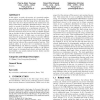Free Online Productivity Tools
i2Speak
i2Symbol
i2OCR
iTex2Img
iWeb2Print
iWeb2Shot
i2Type
iPdf2Split
iPdf2Merge
i2Bopomofo
i2Arabic
i2Style
i2Image
i2PDF
iLatex2Rtf
Sci2ools
CCS
2008
ACM
2008
ACM
HMAC is a randomness extractor and applications to TLS
In this paper, we study the security of a practical randomness extractor and its application in the tls standard. Randomness extraction is the first stage of key derivation functions since the secret shared between the entities does not always come from a uniformly distributed source. More precisely, we wonder if the Hmac function, used in many standards, can be considered as a randomness extractor? We show that when the shared secret is put in the key space of the Hmac function, there are two cases to consider depending on whether the key is larger than the block-length of the hash function or not. In both cases, we provide a formal proof that the output is pseudo-random, but under different assumptions. Nevertheless, all the assumptions are related to the fact that the compression function of the underlying hash function behaves like a pseudo-random function. This analysis allows us to prove the tls randomness extractor for Diffie-Hellman and RSA key exchange. Of independent interes...
| Added | 12 Oct 2010 |
| Updated | 12 Oct 2010 |
| Type | Conference |
| Year | 2008 |
| Where | CCS |
| Authors | Pierre-Alain Fouque, David Pointcheval, Sébastien Zimmer |
Comments (0)

